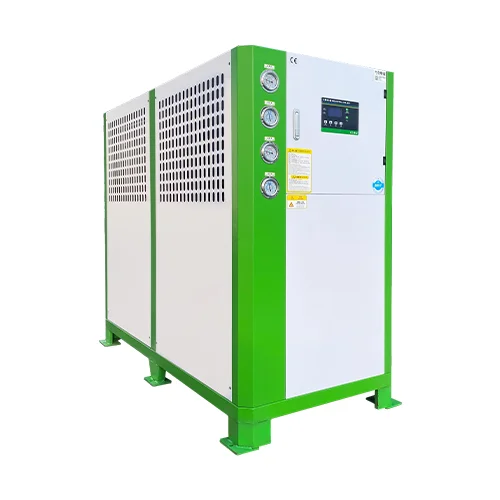في أغسطس 2025, الشركة المصنعة تقرير عن كيفية تغيير نسبة أداء الطاقة الموسمية (SEPR) للطريقة التي تدير بها المصانع الطاقة في أنظمة التبريد الخاصة بها. بالنسبة للشركات التي تستخدم مبردات المياه الصناعيةفإن تكاليف الطاقة والأثر البيئي تتزايد أهميتها. يقيس SEPR كفاءة المبرد على مدار العام بأكمله، مع الأخذ في الاعتبار أحمال التبريد المتفاوتة ودرجات الحرارة الخارجية - وهو أمر لا تغطيه المقاييس التقليدية مثل EER.
وباستخدام بيانات SEPR، يمكن للشركات اختيار المبردات الصناعية المبردة بالماء ووحدات التبريد الصناعية الأخرى التي تعمل بكفاءة وتقلل من التكاليف التشغيلية. على سبيل المثال، يمكن للمبردات عالية الكفاءة من أطلس كوبكو أن توفر عشرات الآلاف من الكيلوواط ساعة سنويًا، مما يقلل التكاليف ويخفض انبعاثات ثاني أكسيد الكربون مع الحفاظ على سلامة المنتجات واتساقها.
نظرًا لأن كفاءة الطاقة أصبحت أولوية قصوى، فإن فهم كيفية تحسين مبردات المياه الصناعية أمر ضروري. ستشارك هذه المقالة نصائح عملية لتحسين الكفاءة وخفض التكاليف في أنظمة التبريد الصناعي.
استهلاك الطاقة في مبردات المياه الصناعية اليوم
تعتمد المصانع في صناعات مثل معالجة الأغذية أو المستحضرات الصيدلانية اعتمادًا كبيرًا على مبردات المياه الصناعية للحفاظ على سير الإنتاج بسلاسة. يمكن أن تستخدم هذه الأنظمة الكثير من الكهرباء، وغالبًا ما تشكل جزءًا كبيرًا من تكاليف التشغيل. يعتمد استخدام الطاقة على عوامل مثل نوع المبرد وحمل الإنتاج ودرجة الحرارة المحيطة، مما قد يجعل إدارة الكفاءة أمرًا صعبًا.
قد تهدر وحدات التبريد الصناعية القديمة التي تعمل بسرعة ثابتة الطاقة عندما يكون الطلب منخفضًا. حتى المعدات التي تتم صيانتها بشكل جيد قد لا تصل إلى ذروة الكفاءة دون مراقبة دقيقة.
كما يؤثر الاستخدام العالي للطاقة على البيئة. فالمزيد من الكهرباء يعني انبعاثات كربونية أعلى، مما قد يجعل من الصعب على الشركات تحقيق أهداف الاستدامة. إن فهم كيفية استخدام نظام التبريد الخاص بك للطاقة هو الخطوة الأولى نحو خفض التكاليف وتقليل الأثر البيئي.

استراتيجيات تحسين كفاءة الطاقة في مبردات المياه الصناعية
لا يجب أن يكون تحسين كفاءة الطاقة في مبردات المياه الصناعية أمرًا معقدًا. يمكن للتعديلات الصغيرة والخيارات الذكية أن تحدث فرقًا كبيرًا في كل من التكاليف والأثر البيئي.
الصيانة الدورية
يضمن لك التنظيف المنتظم للمكثفات والمبخرات والمرشحات تشغيل نظامك بسلاسة. يساعد فحص مستويات سائل التبريد وضغط النظام في الحفاظ على ذروة الأداء، مما يقلل من استخدام الطاقة غير الضروري. حتى إجراءات الصيانة البسيطة يمكن أن تحسن الكفاءة بشكل كبير مع مرور الوقت.
الترقية إلى المكونات الفعالة
يمكن أن يؤدي استبدال الضواغط أو المضخات القديمة بنماذج عالية الكفاءة إلى خفض استهلاك الطاقة. لا تزال بعض المصانع تستخدم مبردات صناعية مزودة بمحركات متغيرة السرعة، والتي تضبط مخرجات التبريد لتتناسب مع الطلب في الوقت الفعلي. تساعد أدوات مثل SEPR (نسبة الأداء الموسمي للطاقة) في تحديد النماذج التي تقدم أداءً ثابتًا على مدار العام
تحسين تصميم النظام
مكان وضع المبردات الصناعية المبردة بالماء وكيفية ترتيب الأنابيب يمكن أن تحدث فرقًا كبيرًا في استخدام الطاقة. حتى التعديلات الصغيرة في التصميم يمكن أن تساعد المبردات على العمل بكفاءة أكبر. إن استخدام أنظمة التحكم البسيطة أو الأتمتة الأساسية لضبط التدفق ودرجة الحرارة حسب الحاجة يمكن أن يمنع إهدار الطاقة عندما يكون الطلب منخفضًا.
مشغلي القطارات
يلعب الموظفون دورًا رئيسيًا في الحفاظ على كفاءة المبردات الصناعية. ويمكن أن يؤدي تعليمهم اكتشاف المشاكل مبكرًا وإجراء تعديلات صغيرة - مثل التحقق من نقاط الضبط أو مراقبة استخدام الطاقة - إلى توفير الكثير من الكهرباء بمرور الوقت.
من خلال الاهتمام بإعداد النظام وممارسات المشغل، يمكن للمصانع تقليل فواتير الطاقة، والحفاظ على تشغيل المبردات بسلاسة، وإطالة عمر مبردات المياه الصناعية.

تحليل التكلفة والعائد
قد يبدو الاستثمار في مبردات المياه الصناعية الأكثر كفاءة مكلفًا في البداية، ولكن غالبًا ما تكون الوفورات على المدى الطويل كبيرة. تستهلك المبردات الصناعية الموفرة للطاقة كهرباء أقل، مما يقلل بشكل مباشر من تكاليف التشغيل بمرور الوقت. العمل مع شركة موثوقة الشركة المصنعة لمبردات المياه الصناعية كما تساعد الشركات على اختيار النماذج التي توازن بين الكفاءة والمتانة والفعالية من حيث التكلفة.
تميل مبردات المياه الصناعية الفعالة أيضًا إلى الحاجة إلى إصلاحات أقل. يعني البلى الأقل أنها تدوم لفترة أطول وتتطلب صيانة أقل. على مدى عقد من الزمن، يمكن أن تكون التكلفة الإجمالية - بما في ذلك الشراء والكهرباء والصيانة - أقل بكثير من الاحتفاظ بالمعدات القديمة الأقل كفاءة.
إن النظر إلى كل من التكاليف الأولية وتكاليف التشغيل يعطي الشركات صورة أوضح. تساعد الخيارات الذكية على تحقيق التوازن بين الأداء والموثوقية والتوفير، مع دعم الاستدامة أيضاً.
الخاتمة
لا يجب أن يعني تشغيل مصنع بمبردات المياه الصناعية ارتفاع فواتير الطاقة. يمكن لخطوات بسيطة، مثل اختيار وحدات فعالة والحفاظ على نظافة المعدات وتدريب الموظفين، أن تحدث فرقاً حقيقياً.
تستخدم الموديلات عالية الكفاءة كهرباء أقل وتميل إلى الاستمرار لفترة أطول من الموديلات القديمة. يساعد قياس الأداء الشركات على اختيار آلات تبريد المياه الصناعية المناسبة وفهم كيفية أدائها على مدار العام.
حتى التحسينات الصغيرة - مثل تعديل تخطيط النظام أو مراقبة استخدام الطاقة - تتراكم بمرور الوقت. لا يؤدي التركيز على الكفاءة إلى خفض التكاليف فحسب، بل يساعد المصانع أيضًا على تحقيق أهداف الاستدامة مع الحفاظ على ثبات الإنتاج وموثوقيته.
